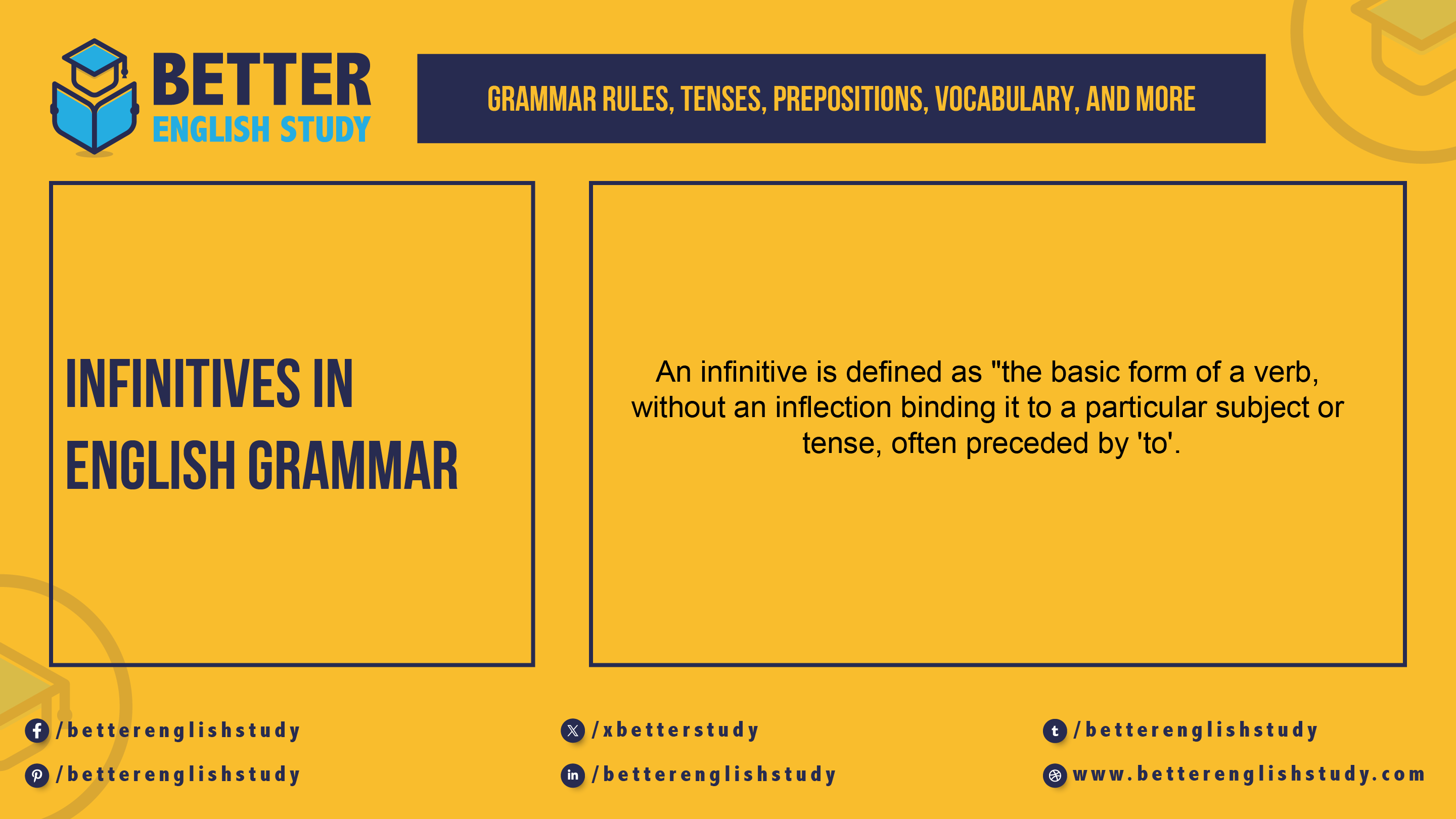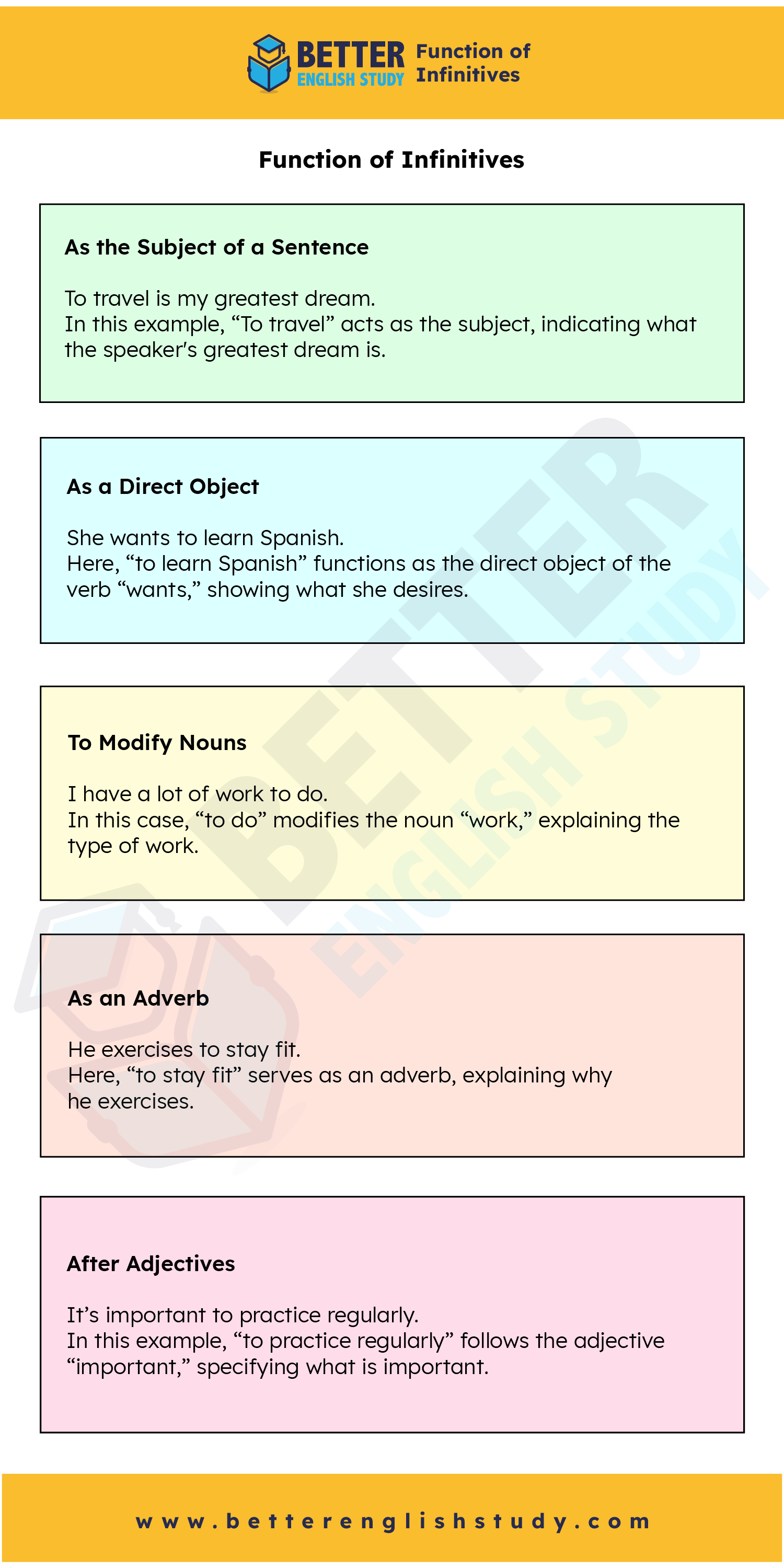
An infinitive is the base form of a verb, typically preceded by the word “to.” Example: “To eat” is an infinitive.
Infinitives are an essential part of English grammar that every learner should understand. Often considered the building blocks of verb usage, infinitives allow speakers to express actions and intentions in a clear and concise manner.
Whether you are writing an essay, crafting a story, or simply engaging in conversation, knowing how to use infinitives effectively will enhance your communication skills. In this article, we will explore the definition, functions, and types of infinitives, along with common mistakes to avoid. By the end, you’ll have a comprehensive understanding of how to use infinitives correctly in your writing and speech.
Definition of Infinitives
According to the Merriam-Webster dictionary, an infinitive is defined as “the basic form of a verb, without an inflection binding it to a particular subject or tense, often preceded by ‘to’.” This definition underscores the infinitive’s role as a neutral form, free from tense or subject-specific changes.
What is the Function of Infinitives?
Infinitives serve various functions within sentences. Here are five examples that illustrate their roles:
- As the Subject of a Sentence
“To travel is my greatest dream.”
In this example, “To travel” acts as the subject, indicating what the speaker’s greatest dream is.
- As a Direct Object
“She wants to learn Spanish.”
Here, “to learn Spanish” functions as the direct object of the verb “wants,” showing what she desires.
- To Modify Nouns
“I have a lot of work to do.”
In this case, “to do” modifies the noun “work,” explaining the type of work.
- As an Adverb
“He exercises to stay fit.”
Here, “to stay fit” serves as an adverb, explaining why he exercises.
- After Adjectives
“It’s important to practice regularly.”
In this example, “to practice regularly” follows the adjective “important,” specifying what is important.

What is an Infinitive Phrase?
An infinitive phrase consists of an infinitive along with any modifiers, objects, or complements. This phrase functions as a noun, adjective, or adverb in a sentence, providing additional detail.
Examples of Infinitive Phrases
- As the Subject
“To read books every day is beneficial.”
Here, “To read books every day” serves as the subject of the sentence.
- As the Direct Object
“He decided to visit his grandparents.”
In this case, “to visit his grandparents” is the infinitive phrase acting as the direct object of “decided.”
- To Modify Nouns
“She has a plan to improve her grades.”
Here, “to improve her grades” modifies the noun “plan.”
- As an Adverb
“They went to the gym to work out.”
In this example, “to work out” provides information about why they went to the gym.
- As a Subject Complement
“His goal is to become a doctor.”
Here, “to become a doctor” serves as a subject complement, providing more information about “his goal.”
Types of Infinitives
Infinitives can be categorized into several types based on their usage in sentences.
1. Full Infinitives
A full infinitive is the base form of a verb preceded by “to.” It can function in various roles within a sentence.
- To Show Purpose or Intention
Example: “She studies hard to succeed.”
In this sentence, “to succeed” indicates the purpose of her studying.
- To Modify Nouns
Example: “He has a desire to learn.”
Here, “to learn” modifies the noun “desire.”
- As the Subject of a Sentence
Example: “To run a marathon takes dedication.”
In this case, “To run a marathon” serves as the subject.
- After Adjectives
Example: “It’s easy to understand the concept.”
Here, “to understand the concept” follows the adjective “easy.”
- With the Words Too or Enough
Example: “The exam was too difficult to pass.”
In this instance, “to pass” modifies “difficult.”
2. Bare Infinitives
A bare infinitive is the base form of a verb without “to.” It often follows certain verbs and expressions.
- After Modal Verbs
Example: “She can swim very well.”
In this case, “swim” is the bare infinitive that follows the modal verb “can.”
- After Perception Verbs
Example: “I heard him sing.”
Here, “sing” is the bare infinitive that follows the verb “heard.”
- With the Verbs Let, Make, and Do
Example: “Let him go.”
In this instance, “go” is the bare infinitive.
- With the Relative Pronoun Why
Example: “I don’t know why she left.”
Here, “left” is the bare infinitive following the relative pronoun.
3. Split Infinitives
A split infinitive occurs when an adverb or other word is inserted between “to” and the verb. While this can be stylistically debated, it is often acceptable in modern English.
- Example:
“She decided to quickly finish her homework.”
In this sentence, the adverb “quickly” splits the infinitive “to finish.”
4. Passive Infinitives
A passive infinitive is formed by using “to be” followed by the past participle of a verb. It emphasizes the action being done to the subject rather than by the subject.
- Example:
“The book is to be read by everyone.”
Here, “to be read” indicates that the action of reading is to be performed by others.
5. Continuous Infinitives
A continuous infinitive is formed using “to be” followed by the present participle of a verb. It expresses an ongoing action.
- Example:
“He seems to be running late.”
In this case, “to be running” indicates the ongoing action of running.
Infinitives and Gerunds
Infinitives and gerunds both function as verbs in a sentence, but they have different roles. An infinitive expresses the base form of a verb, often denoting an action or purpose, while a gerund acts as a noun and represents an ongoing action.
- Example of an Infinitive:
“To swim is fun.”
Here, “To swim” is the subject of the sentence.
- Example of a Gerund:
“Swimming is fun.”
In this case, “Swimming” acts as the subject, indicating an ongoing action.
Rules to Form Infinitives
To form an infinitive, simply use the base form of the verb with the particle “to.” For example:
- Base verb: “run” → Infinitive: “to run”
- Base verb: “write” → Infinitive: “to write”
Common Mistakes with Infinitives
Here are five common mistakes people make when using infinitives, along with corrections:
- Incorrect: I want to going to the party.
Correct: I want to go to the party.
- Incorrect: She decided to studying abroad.
Correct: She decided to study abroad.
- Incorrect: He is looking forward to meet you.
Correct: He is looking forward to meeting you.
- Incorrect: They hope to seeing the movie.
Correct: They hope to see the movie.
- Incorrect: I would like to playing the piano.
Correct: I would like to play the piano.
10 Examples of Infinitives
- My dream is to travel the world.
- He wants to become a chef.
- It’s important to stay focused.
- She plans to visit her family next month.
- One way to improve your health is to exercise regularly.
- They decided to go hiking this weekend.
- It takes time and effort to learn a new language.
- He promised to help me with my project.
- I need to finish my homework before dinner.
- It requires dedication to succeed in life.
Conclusion
Understanding infinitives is crucial for mastering English grammar. They serve multiple functions, including acting as subjects, objects, and modifiers, and can take on various forms such as full, bare, passive, and continuous infinitives. By recognizing how to use infinitives correctly, you can enhance your writing and communication skills significantly. Remember to pay attention to common mistakes to ensure clarity in your expressions. With practice, you will become more confident in using infinitives effectively in your everyday language.
